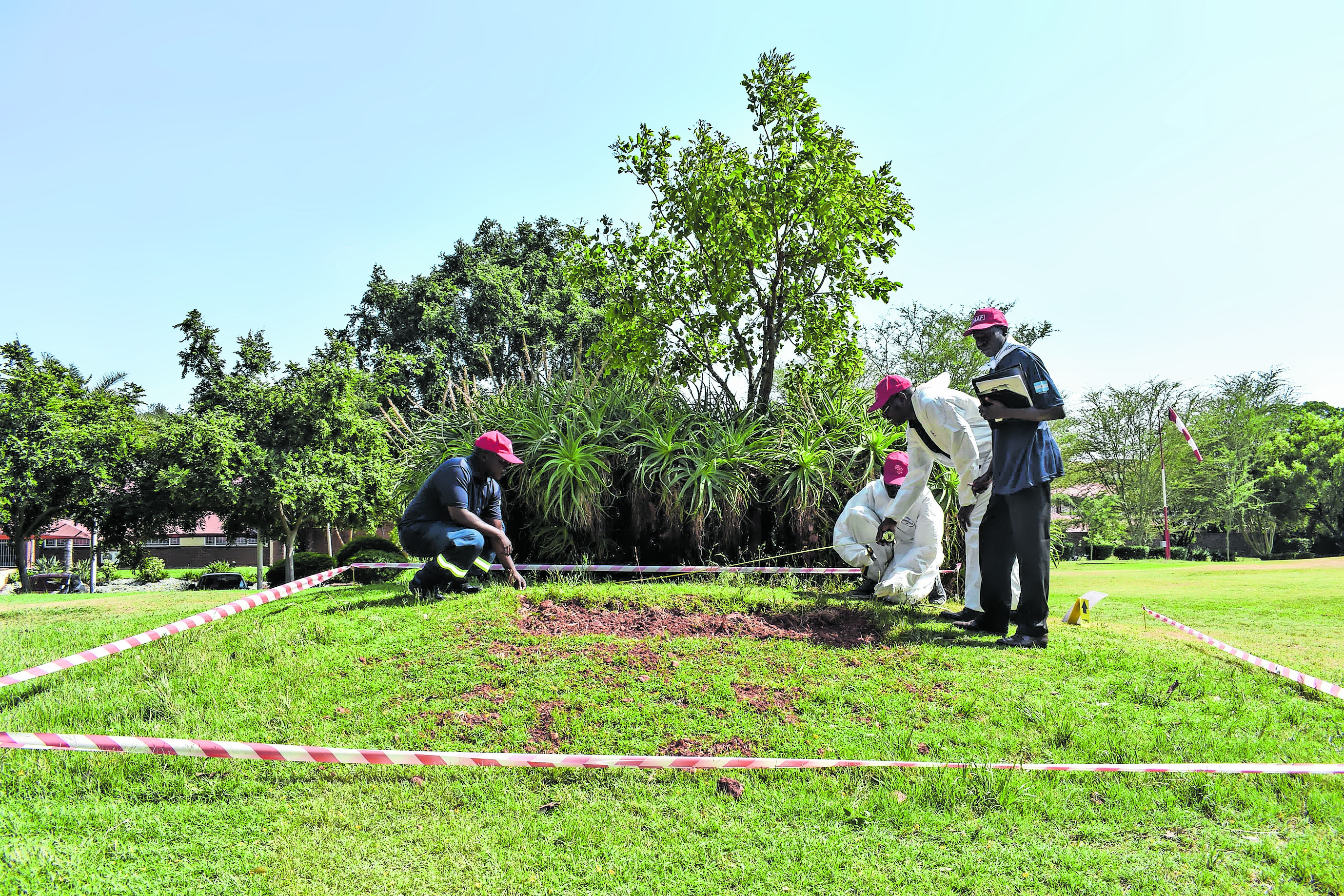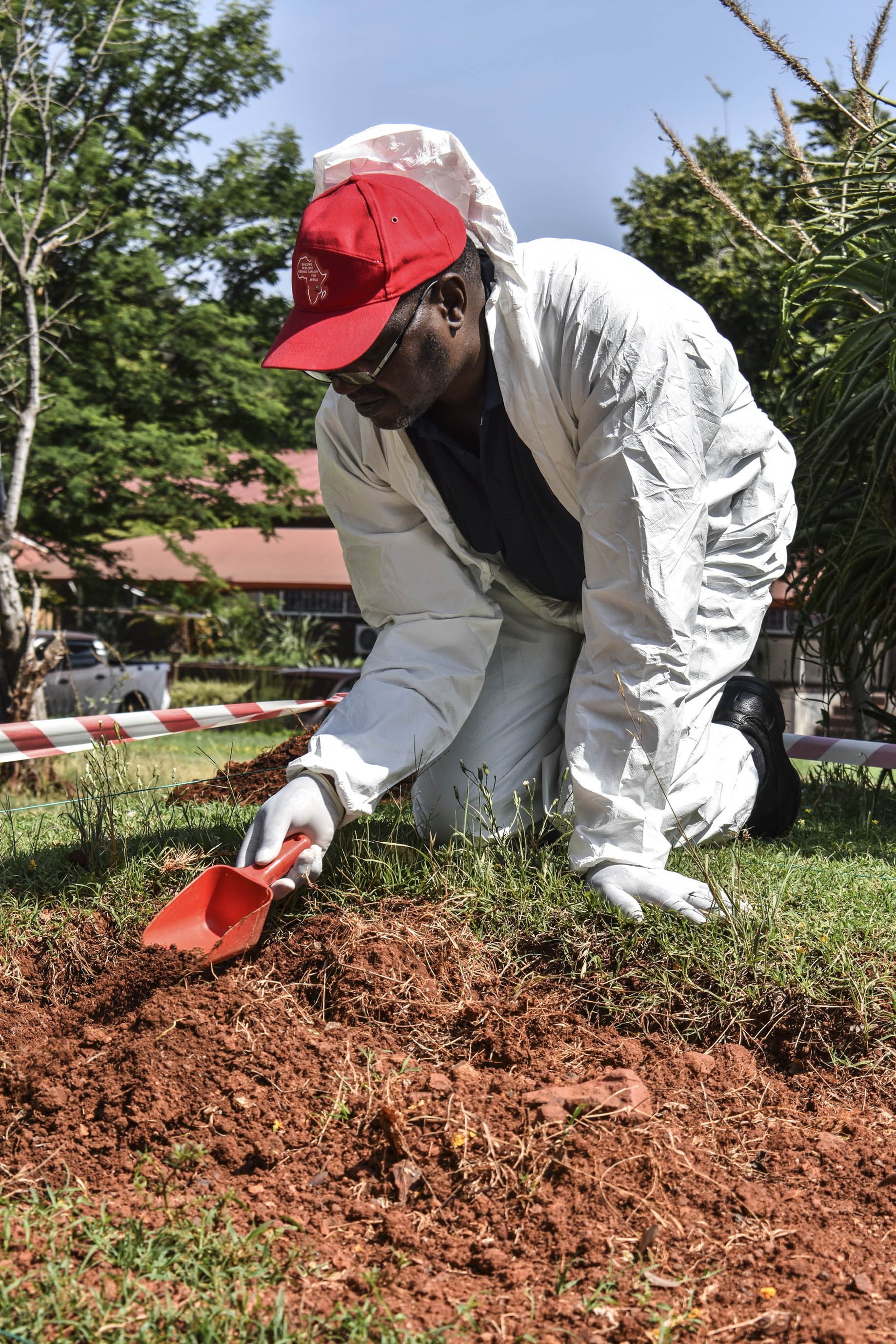Professionals from the rest of Africa, including South Sudan learn to dig up bodies, taking care to preserve clues about their identity or cause of death. (Simon Allison/M&G)
It is not a good day to be digging up the dead. On this particular Wednesday in November, a hot wind blows through central Pretoria, stirring up dust and knocking over location markers. The diggers, sweating inside their white plastic protective suits, look especially miserable.
There are three graves being exhumed in this otherwise quiet, peaceful garden on the campus of the Pretoria Forensic Services unit.
The forensics teams huddled around the graves don’t have much information to work with. They were told there was some suspect activity in this area, and that people have been burying bodies. It is now their job to find those bodies, and to figure out how they died.
Step one is to secure the scene, with pegs and red-and-white tape. Step two is to dig, slowly and methodically, until bone is struck: a skull, perhaps, or a shin bone. Then the rest of the body — or bodies — must be uncovered, photographed and documented for the investigation to follow. Also documented is anything else found in the grave that offer clues to the identity of the bodies, or what happened to them: jewellery, clothing, watches.
It looks like an archaeological dig, and the work is equally slow and painstaking. Only after hours of hard labour in the hot sun can the bones be bagged up and carried away into storage, until they are needed again.
Dapper Cadavers
The lack of stench gives it away: these bones are fake, although they look disturbingly life-like. They were bought from an online store called Dapper Cadaver — “a death-related prop house and prop fabrication shop”, according to its website — which specialises in verisimilitudinous body parts, usually for Hollywood or high-end Halloween parties, but sometimes for specialist organisations that train people in the management of the dead.
In the Pretoria Forensic Services garden, the Dapper Cadavers are carefully buried in training graves — almost certainly the busiest graves in Southern Africa — which are used repeatedly to teach students to exhume human remains properly. Last week, it was a group of 16 students, in town to attend the three-week African School of Humanitarian Forensic Action. There are students from the Democratic Republic of Congo, the Gambia, Mozambique, South Sudan, Kenya, South Africa and Georgia.
The course is organised by the International Committee of the Red Cross (ICRC) and the Argentine Forensic Anthropology Team. The latter, a nongovernmental organisation, was established in the 1980s to connect the desaparecidos — the tens of thousands of people who had been “disappeared” by Argentina’s brutal military junta — with hundreds of unidentified bodies that had been found stuffed into plastic bags and left in dusty storerooms at state medical facilities.
Dignity for the dead
Under international humanitarian law, bodies must be handled with dignity, and every effort made to identify them and inform their families. This is especially true with natural disasters, epidemics and conflict-related deaths. It’s not just about respecting the dead, although that is a primary consideration; it is also about preserving any evidence that might be needed later in an investigation, or any clues that might help to identify bodies.
But on the African continent, the necessary forensic skills are in short supply. For example: “There is basically no forensics capacity in the Great Lakes region. Rwanda has quite an advanced lab. But there’s only one forensic pathologist in the Democratic Republic of Congo, and he’s retired. And there’s one in the Central African Republic, but he’s also a traumatologist, so he’s quite busy,” said Marie Dussault, the forensics specialist for the ICRC in the Great Lakes region.
 The first step is to secure the scene (above). Then slowly they dig until bone is exposed (below). (Simon Allison/M&G)
The first step is to secure the scene (above). Then slowly they dig until bone is exposed (below). (Simon Allison/M&G)

That’s where the African forensics school comes in. Now in its third year, students are given a crash course in the science of death management. They learn about designing a mortuary, photographing corpses, processing mass fatality scenes, gathering information from traumatised families, exhuming human remains and performing autopsies, among other morbid — but vitally important — subjects.
The course is targeted at professionals from countries without much in the way of forensics capacity — usually doctors, prosecutors and investigators, the kind of people who are likely to come into contact with bodies in the course of their work.
People like Alagie Barrow, the director of research for the Gambia’s Truth, Reconciliation and Reparations Commission. The commission was established to investigate crimes committed during the regime of former Gambian president Yahya Jammeh. At the exhumation training, Alagie has been given the role of filling out the forms, a boring but essential part of the process. But he is paying close attention to what everyone else is doing, in case one day he has to do it himself.
“If we come across a grave [in the Gambia], we don’t know what to do with it,” said Alagie. “We can’t learn much here in three weeks. But we can learn the basics. I’ll know how to secure the perimeter, at least.”
These skills are all a vital part of giving closure to grieving families.
“Families continue to search for credible answers to the difficult questions that arise when their loved ones cannot be found following a disaster or conflict. They have a right to know,” said the ICRC’s forensic co-ordinator for Africa, Stephen Fonseca, when the course was launched in 2016. “The complex conflicts, mass casualty incidents and migration within Africa are creating a growing need for the scientific and systematic answers that humanitarian forensic action can provide.”